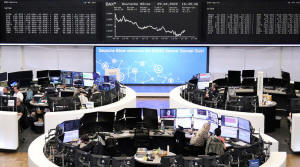Global stocks rally, Europe at record highs, dollar gains
 Send a link to a friend
Send a link to a friend
 [May 11, 2024]
By Herbert Lash and Amanda Cooper [May 11, 2024]
By Herbert Lash and Amanda Cooper
NEW YORK/LONDON (Reuters) -A rally in global equity markets lifted
stocks in Europe to record highs on Friday amid strong corporate
earnings and hopes central bank interest rate cuts are near, while the
dollar edged higher despite signs of slowing U.S. economic growth.
European shares posted their biggest weekly gain since late January,
with the pan-regional STOXX 600 index rising for a sixth straight
session, while the FTSE 100 in London hit yet another record high.
The Dow industrials index registered its eighth daily advance as the
three major Wall Street indexes posted weekly gains but the Nasdaq
closed marginally lower on the day.
Strong performance on both sides of the Atlantic, along with gains
overnight in Tokyo and elsewhere in Asia, pushed MSCI's all-country
world index within 0.2% of a record closing high.
U.S. equity markets took comfort from earning season as corporate
results in aggregate beat expectations, said Dec Mullarkey, managing
director of investment strategy and asset allocation at SLC Management
in Boston.
"It certainly gave some assurance that growth is holding up while
companies protect profit margins," Mullarkey said, referring to
corporate America.

While in Europe, "the prospect of rate cuts is helping drive equity
markets across the euro zone as it still looks like a decent value play
to global asset allocators," he said.
The pan-European STOXX 600 index closed up 0.77%, the FTSE ended 0.63%
higher and MSCI's gauge of stocks across the globe rose 0.31% - just
0.2% from a new closing high.
The Dow Jones Industrial Average rose 0.32%, the S&P 500 gained 0.17%
and the Nasdaq Composite eased 0.03%.
The dollar pared initial declines and turned modestly higher as
investors assessed a reading on U.S. consumer sentiment and sifted
through a flurry of comments from Fed officials.
The University of Michigan's preliminary reading of consumer sentiment
came in at 67.4 for May, a six-month low and below the 76.0 estimate of
economists polled by Reuters. In addition, the one-year inflation
expectation climbed to 3.5% from 3.2%.
"The U.S. exceptionalism trade is fading. We did see a decline
yesterday based on the higher-than-expected rise in jobless claims,"
said Karl Schamotta, chief market strategist at Corpay in Toronto.
"The underlying trend here does look as if the dollar's essentially
peaking here and then it might decline."
The dollar index, which measures the U.S. currency against a basket of
six peers, gained 0.07% to 105.29. The euro slid 0.1% to $1.077, while
the yen weakened 0.17% to 155.74 per dollar. The pound posted a modest
weekly loss after the Bank of England on Thursday paved the way for the
start of rate cuts as soon as next month and data showed the British
economy exited a mild recession in the first quarter of this year.
[to top of second column] |

The German share price index DAX graph is pictured at the stock
exchange in Frankfurt, Germany, April 29, 2024. REUTERS/Staff/File
Photo

INFLATION AHEAD
Markets await both next week's producer price index and the
consumer price index for signs that U.S. inflation has resumed its
downward trend toward the Fed's 2% target rate.
Hotter-than-expected inflation reports last month had quashed any
lingering expectations of near-term U.S. rate cuts. But markets are
now fully pricing in a cut only in November, while chances of the
Fed moving in September have narrowed.
In contrast, markets now imply a 50-50 chance of a BoE cut in June
and are almost fully priced for August. They also imply an 88%
chance the European Central Bank will ease in June.
BOE Governor Andrew Bailey said there could be more reductions than
investors expect, the latest sign of the growing divergence between
the Europe and U.S. rate outlooks.
Traders currently anticipate roughly 42 basis points of cuts this
year from the Fed. In comparison, traders are pricing in 55 bps of
easing from the BoE this year, while anticipating 68 bps of cuts
from the ECB.
Treasury yields rose as traders waited on next week's key April
inflation data to guide expectations of Fed monetary policy.
The yield on benchmark 10-year Treasury notes rose 5.1 basis points
to 4.5%, while the two-year yield, which typically moves in step
with interest rate expectations, rose 6.3 basis points to 4.8698%.
Oil prices fell by about $1 a barrel as comments from Fed officials
indicated higher-for-longer interest rates, which could hinder
demand from the world's largest crude consumers. U.S. crude futures
fell $1.00 to settle at $78.26 a barrel and Brent settled down $1.09
at $82.79 a barrel.
Gold prices rose, en route to their best week in five, with
zero-yield bullion building on momentum fueled by weaker U.S. jobs
data this week that reinforced expectations for the Fed to cut rates
this year.
U.S. gold futures for June delivery settled 1.5% higher at
$2,375.00 per ounce.

Bitcoin fell 3.19% to $60,613.00.
(Reporting by Herbert Lash, additional reporting by Amanda Cooper
and Ankur Banerjee; Editing by Ros Russell, Kirsten Donovan, Nick
Zieminski and Jonathan Oatis)
[© 2024 Thomson Reuters. All rights
reserved.]
This material may not be published,
broadcast, rewritten or redistributed.
Thompson Reuters is solely responsible for this content. |